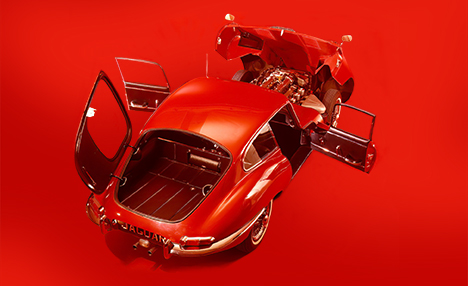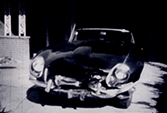Originally printed in the 1959 issue of Road Test Magazine
The parallels between General Motors in this country and the British Motors Corporation in England are many. Both are the largest in their respective countries, both build close to half of all cars produced at home. Also, both build sports cars.
But whereas GM builds only the Corvette, the BMC combine has had two, the MG and the Austin-Healey. Now we have a third car to add to the list, the long-awaited Morris Minor version, first predicted in R&T back in November, 1952.
Technically, the new low-priced sports car is to be known as the Austin-Healey Sprite. It is not quite clear why: the car wasn’t designed and will not be built by Donald Healey, and the only previous Sprite was a Riley model built before the war. Mechanically, the new Sprite is more Austin than anything else, with engine, gearbox, front suspension and rear axle all being developed from components originally found in the Austin A-30 (now the A-35).
As for appearance, it is obvious that BMC does not follow GM’s practice of allowing its artists to relieve their frustrations by styling sports cars. These lines were developed by the body structural engineers to be simple and cheap to form, and to be adequately rigid without the formality of a separate frame. Even the British press says very little about the looks of this new baby —one writer says the shape was developed in a wind tunnel, another opines that the appearance tends to grow on you. We would be inclined to discount both reports.
Incidentally, the reason for the frog-like headlights is rather simple: the original design called for concealed lights which popped up when required. Production costs were too high, and the net result has pretty well ruined what otherwise could have had a certain coltish appeal.
Appearance notwithstanding, the Sprite has some very attractive features for the prospective purchaser, among them being 1) low price, 2) comfortable seating and driving position, 3) surprisingly good performance and 4) really excellent handling qualities.
The car stands just 4 feet high with its top up. Entrance or exit is a little awkward, not so much because of the lowness as because the door hinge point is too close to the seat. It is very difficult to get an average-sized foot through the narrow space provided. Once one is sealed, the amount of pedal and leg room is a real surprise —more than in the MG-A. The bucket seats are more comfortable than those in the A, but are too nearly vertical for adequate back support on long trips. The low top restricts vision at the sides.
The tiny 948-cubic centimeter engine starts instantly and has an authentic sports car rumble that still holds the exhaust note within legal standards. It revs freely and smoothly, with only a little vibration noticeable when decelerating. When it is pressed hard, 6000 revolutions per minute can be attained in the gears without valve lifter noise. We used 5500 rpm as a limit during the acceleration tests because the unit still seemed a little tight, even though the break-in mileage had been reached. Incidentally, the brake horsepower figure quoted in the data panel is the one supplied us, but British reports give quite a different figure of 43 blip at 5200 rpm. We suspect that 43 blip is accurate, and that the 48 blip is under SAE conditions.
The clutch is light, smooth and has a short pedal travel. Its life also may be short, as it definitely slipped after the second all-out standing start test. The gearshift control is beautifully worked out and perfectly located. Unfortunately our test car’s lever was so stiff that it could only be moved by brute force from neutral to 1st and from 1st to 2nd. We put over 600 miles on the car ourselves and it did not seem to be “freeing up with use.” as claimed. Second gear is much too low except for those drivers who like to use an American 3-speeds-forward pattern. This shows up in the short spurt between dots on our usual acceleration chart. Third and 4th gears shift easily and are well chosen ratios for average use.
For our tastes, high gear is too low. An axle ratio of about 3.9:1 would make 70-mph cruising a little less noisy. The noteworthy silence of 3rd gear would make such a proposal quite feasible and give a brisk city-driving ratio of 5.51:1 overall, instead of the present 5.96 ratio used for 3rd. As it stands now, 4000 rpm in 4th is equivalent to 61 mph, and that’s a comfortable cruising speed. Of course 5000 rpm and 76 mph is theoretically safe, but the engine is spinning a little too fast at that rate to feel really serene for hours at a time, even though experience with this power plant proves that it can be done.
The greatest virtue of the Sprite is without a doubt its excellent steering and handling qualities. With a rack and pinion gear, the turns, lock to lock, are 2.3. This is quick steering, even for a sports car, but once the driver becomes familiar with it there is no objection. In fact, the steering is nearly perfect for the purpose, and light and accurate besides. Cornering characteristics are very close to neutral, with just a very small amount of understeer at moderate speeds. It is very hard to force the rear end to break loose, and when it does, the action is neither violent nor hard to control. The front end appeared to be out of alignment on the test car. as the tires were already wearing badly with only 1000 miles on the odometer. This could account for some of the understeer tendency.
At the rear we find a double trailing link type of suspension by quarter-elliptic springs at the bottom and link rods at the top. This system gives favorable low unsprung weight and lies in well with the frameless body construction. Traditionally, quarter-elliptic springs have meant a hard, sometimes choppy ride, and this is true of the Sprite. It does rule exceptionally well for so small a car. and because the independent front suspension system employs coil springs which are softer in action than the rear springs, fore and aft pitching is not too objectionable. In general the ride compares favorably with that standard, the MG. and there is even less roll.
In all fairness there are a few objectionable features about this car, mostly in the nature of bugs which will be corrected in subsequent production models. A marginal clutch has already been mentioned and we accidentally discovered the hand brake lever to be rather shoddy—it broke.
The body panel fit was not too good on this early sample. A check with a 3-foot straightedge revealed some poor forming work, with hollow contours where one would have expected a slight convexity. Raising the hood is inconvenient, the handle and safety catch being so located that your hand scrapes the lower edge of the license plate and the back edge of the front bumper.
The entire front end of the bod) must be raised, and it is rather heavy, yet flexible. The self-locking struts must he carefully latched one at a time, and then the rather flimsy looking safety rod can be put in position. Accessibility is surely as good as on any contemporary car.
Because there is no trunk lid. access to the spare tire and tools is awkward, particularly if any luggage is being carried at the time. The seat hacks do hinge forward, which makes it possible to gel one foot in behind them when loading or unloading the trunk. The omission of a lid is, in this case, more than a cost-saving expedient, for the entire rear end of the body is stiffened considerably by being welded together as one piece. However, the bumper mountings, particularly at the rear, do not look capable of withstanding the American back-till-you-hear-something type of parking. The only objections to the interior were the seat backs, the knuckle scraping clearance between the shift lever and the instrument panel, and the green direction signal indicator light. Located directly in front of the driver, it is positively blinding at night.
The top covering is removed from the top bows for folding and storage, a feature which certainly saves wear and tear, and the bows nest neatly in rattle-proof sockets. However, the simple type of flap which snaps across the top of the windshield has never been noted for keeping out rain, and the fit of the side curtains (or lack of it I also seems to indicate that water leaks may be a problem.
We believe the Sprite has quite a potential for safe sport in production car racing. Undoubtedly we shall soon see the under 1100 cc-class races being overwhelmed with entries under the new marque. A Porsche 1098-cc model could readily defeat the Sprite, but such opponents are rare in this country. The brakes on the Sprite would probably need a little improvement for competition, though they are more than adequate for normal driving.
We found the Austin-Healey Sprite a most significant and exciting new model. It fills the broad gap between the Berkeleys and the MG-A with a genuine sports car at a price. Despite a few obvious faults, it will be popular. It offers more fun per dollar than anything we have driven for a long time.







'From the Archives…Road Test – Austin-Healey Sprite' has no comments
Be the first to comment this post!